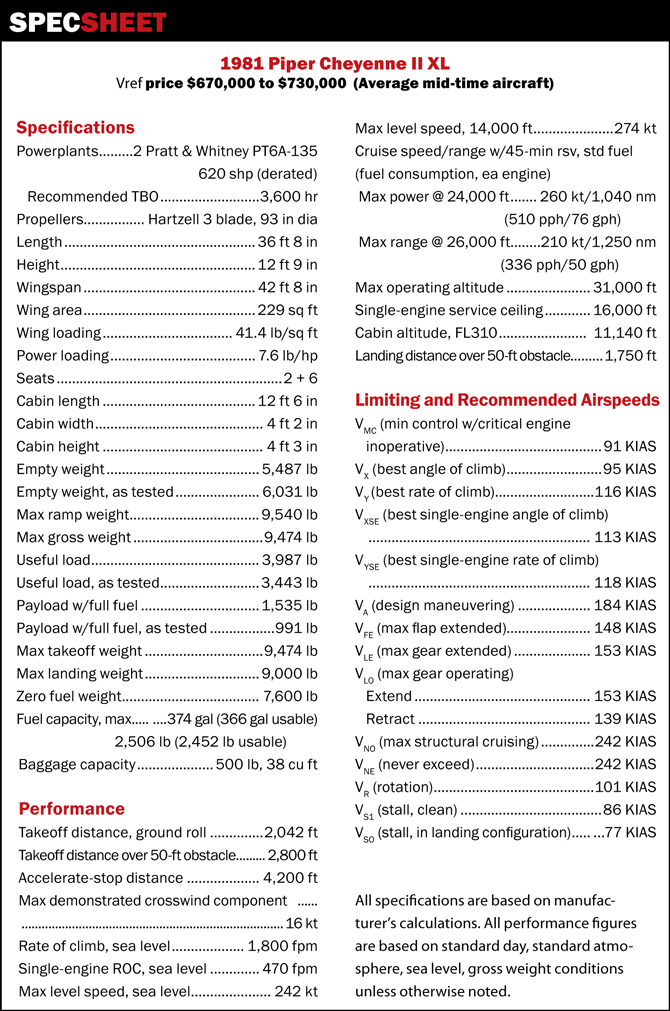Jet or turboprop?
This owner decided to keep his Piper Cheyenne II XL
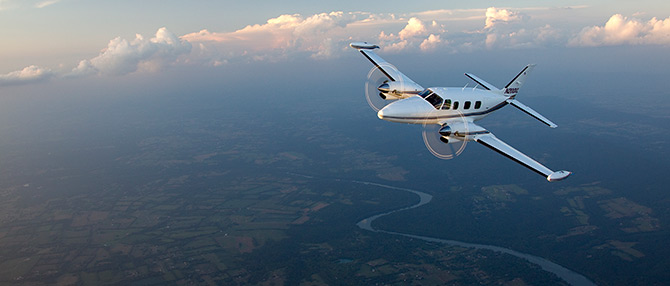
October 2011
Turbine Pilot Contents
- Turbine Intro: Twin Turboprop for the Masses: Putting value into turbine operations
- Jet or turboprop? This owner decided to keep his Piper Cheyenne II XL
- 200 Feet, Lights in Sight: Low ILS approaches call for a tricky transition
- Consolidation of Knowledge: Ways to avoid post-grad brain dump
Photography by Chris Rose
Entry-level jets were so tempting to Jeffrey Brausch, a member of the Air Safety Institute Board of Visitors, that he looked at nearly every offering on the market. When decision time came in 1999, the model he wanted most was the one he already owned, a pristine 1981 Piper Cheyenne II XL.
Brausch’s Cheyenne II XL
When he purchased the aircraft, it had new paint and interior and recently overhauled engines, but the panel was outdated. It was even difficult to maintain because of its age. Since he planned to keep the aircraft 10 or 15 years, he took it to Carpenter Avionics in Smyrna, Tennessee, for the largest project that company had ever done: more than $250,000. It included the two-tube Bendix/King Electronic Flight Instrument System (EFIS) 40, two Garmin GNS 430 GPS/coms (now replaced by two Garmin GNS 530Ws with roll steering), L-3 Stormscope, L-3 Skywatch, a Bendix/King 860 enhanced ground proximity warning system, more powerful digital radar, a Bendix/King 850 multifunction display, dual transponders, two Sandel HSI displays, an Argus 7000 moving-map display, and co-pilot vacuum-driven instruments with a battery-powered pilot’s artificial horizon. A second back-up battery was added to run the Garmin radio if everything else failed.
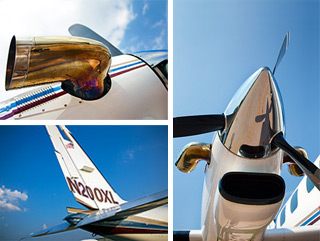 Components of the anti-icing system include electrically heated induction air inlets, propeller boots, and inertial separators. The exhaust stacks were modified under a supplemental type certificate and improve the appearance and maintainability of the aircraft.
Components of the anti-icing system include electrically heated induction air inlets, propeller boots, and inertial separators. The exhaust stacks were modified under a supplemental type certificate and improve the appearance and maintainability of the aircraft.
When the upgrades were complete, Brausch could turn off the master switch and both generators if necessary in an emergency, and still have communications, an artificial horizon, altimeter, and navigation.
Cheyenne Air Service in Washington, Pennsylvania, installed American Aviation’s pitot cowling ram air recovery system, giving him an extra seven knots at altitude. “The effect is to recover more ram air for the compressors, and you actually make more power,” Brausch said. He also had the exhaust stacks modified. “I don’t know that there’s much improvement there, maybe a couple of knots, but they look better and reduce exhaust residue on the airframe.” While he flight plans for 265 knots true airspeed, he will often see 270.
The best he’s ever owned
“In many ways, it’s the best aircraft I’ve ever owned,” said Brausch. One of the capabilities he likes most is the Cheyenne’s crosswind-landing capabilities. He recalled landing at Goose Bay in Newfoundland, Canada, on a fishing trip when winds were 45 knots, but the runway the winds favored was closed. He needed a huge crab angle to align with the centerline of the remaining runway.
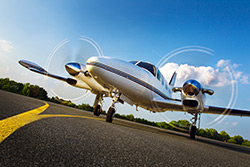 An unpressurized baggage area in the nose holds 300 pounds.
An unpressurized baggage area in the nose holds 300 pounds.
“We literally were looking out the side window,” Brausch said. He kept in mind an emergency alternate airport not far away if needed. He planned to make a couple of tries before going to the alternate, yet he got in on the first attempt. “I just transitioned out the crab, lowered the wing, touched down on one wheel, ran it down the runway probably 1,000 feet on one wheel, dropped it down, pulled back one propeller and advanced the other one.”
The airplane is also very good at shedding ice, as it must be during Ohio winters. Brausch is based at Medina, Ohio. He said that performance becomes “anemic” above 25,000 feet, so he stays between 18,000 and 25,000 feet for most trips. “The aircraft is an excellent platform in instrument conditions, and easily hauls five or six people with good IFR range capability,” he said.
A business machine
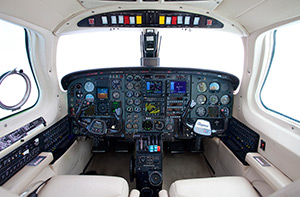 Most of his annual flying hours (this year he will approach 300 hours) are used for business. “The nature of my business is financial consulting, and you go to the client,” Brausch said. “We go to clients within a radius of 750 nautical miles from Akron-Canton [Regional Airport].
Most of his annual flying hours (this year he will approach 300 hours) are used for business. “The nature of my business is financial consulting, and you go to the client,” Brausch said. “We go to clients within a radius of 750 nautical miles from Akron-Canton [Regional Airport].
“I’m always going into contaminated runways in the winter in Michigan, Kentucky, Ohio, and Pennsylvania, I am very pleased to have a turboprop because I have a lot more directional control when I touch down on patchy ice or snow. I can steer with the propellers.” With a jet, he expects he would have to use larger fields, rent a car, and then drive farther to his destination.
“The turboprop allows me to get closer to my client,” he said.
No stability system
 The landing gear is hydraulically actuated with a nitrogen back-up system, and has proven very reliable.
The landing gear is hydraulically actuated with a nitrogen back-up system, and has proven very reliable.
The very first Cheyenne to fly was the Cheyenne II, not the Cheyenne I or the II XL, and it was flown by test pilot Jack Wetzel, now of Wetzel Aviation in Englewood, Colorado.
“It [the stability augmentation system] had always been on the Cheyenne II,” Wetzel recalled. He was a Piper test pilot on the Cheyenne from 1969 to 1974. “During the certification period, [the stability augmentation system] had some issues and areas where it fell short.” The system was not required on the follow-on, less-expensive Cheyenne I because it has lower-powered engines, and not on the XL because it has a longer fuselage (that provides the needed pitch stability).
Brausch said there are added benefits with the XL. “First of all, the two-foot plug gives you a lot more room inside, but it also took away the problem of instability,” he said. The plug was added in the area ahead of the main spar.
Not going to jets
 The avionics suite is designed for redundancy and to serve the needs of the co-pilot.
The avionics suite is designed for redundancy and to serve the needs of the co-pilot.
“I’ve looked at the [Cessna] CitationJet, and I’ve looked at the [Embraer] Phenom. I was never seriously looking at the Eclipse because I thought it was too small, and in my mind, the performance numbers were problematic. But, I don’t think I’ll likely go to a jet,” Brausch said.
“One thing is fuel costs have gotten so high. Jets burn, for the same stage length, maybe 30 to 50 percent more fuel than I’m burning.
“I would lose the ability to use smaller, contaminated runways, and I don’t get there that much faster,” Brausch said. On longer flights, a jet might beat his turboprop by an hour, but on shorter flights, the difference is reduced to minutes, he said. Brausch said his dispatch reliability is more than 99 percent. He is considering upgrading from his stock PT6 engines to Blackhawk PT6A-135A engines and adding new engine instruments in the future. The upgraded engines will provide more power at higher altitudes, and come with digital engine instruments for the panel.
Cutting to the chase, it costs Brausch $1,168 per hour to operate his Cheyenne II XL. The figure includes both variable costs of $978 per hour and fixed costs of $190 per hour, based on flying 300 hours per year.
Variable per-hour costs include fuel at $447, based on maximum cruise power at 20,000 feet, with Jet A priced at $5.50 per gallon.
Fixed costs include a hangar at $18,000 a year, insurance at $20,100 a year, database updates, and $6,000 for his yearly retraining.
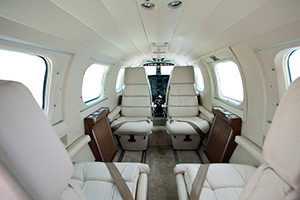 The interior accommodates six adults and has a side-facing, belted, flushing toilet (not shown) opposite the airstair door. An additional full-size eighth seat is available for quick installation.
The interior accommodates six adults and has a side-facing, belted, flushing toilet (not shown) opposite the airstair door. An additional full-size eighth seat is available for quick installation.
Cheyenne or King Air?
Wetzel said the Cheyenne can carry an impressive load. He understandably supports the aircraft he helped to develop.
“If I was going to haul six people, I would go for the Cheyenne II XL,” Wetzel said.
Wetzel thinks the Cheyenne tops the King Air as the best choice.
“The generalization is that if the guy buying it is a pilot, he will buy the Cheyenne. If he is going to ride in the back, he will buy a King Air. The Cheyenne, performance-wise, is a better value. The King Air stands taller and the cabin is bigger, so the guy in back has a tendency to feel more important. If you are spending your own hard-earned money, you want the biggest bang for the buck.”
Email the author at [email protected].
